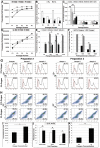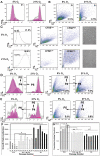Atmospheric oxygen inhibits growth and differentiation of marrow-derived mouse mesenchymal stem cells via a p53-dependent mechanism: implications for long-term culture expansion
- PMID: 22367737
- PMCID: PMC3683654
- DOI: 10.1002/stem.1069
Atmospheric oxygen inhibits growth and differentiation of marrow-derived mouse mesenchymal stem cells via a p53-dependent mechanism: implications for long-term culture expansion
Abstract
Large scale expansion of human mesenchymal stem cells (MSCs) is routinely performed for clinical therapy. In contrast, developing protocols for large scale expansion of primary mouse MSCs has been more difficult due to unique aspects of rodent biology. Currently, established methods to isolate mouse MSCs select for rapidly dividing subpopulations that emerge from bone marrow cultures following long-term (months) expansion in atmospheric oxygen. Herein, we demonstrate that exposure to atmospheric oxygen rapidly induced p53, TOP2A, and BCL2-associated X protein (BAX) expression and mitochondrial reactive oxygen species (ROS) generation in primary mouse MSCs resulting in oxidative stress, reduced cell viability, and inhibition of cell proliferation. Alternatively, procurement and culture in 5% oxygen supported more prolific expansion of the CD45(-ve) /CD44(+ve) cell fraction in marrow, produced increased MSC yields following immunodepletion, and supported sustained MSC growth resulting in a 2,300-fold increase in cumulative cell yield by fourth passage. MSCs cultured in 5% oxygen also exhibited enhanced trilineage differentiation. The oxygen-induced stress response was dependent upon p53 since siRNA-mediated knockdown of p53 in wild-type cells or exposure of p53(-/-) MSCs to atmospheric oxygen failed to induce ROS generation, reduce viability, or arrest cell growth. These data indicate that long-term culture expansion of mouse MSCs in atmospheric oxygen selects for clones with absent or impaired p53 function, which allows cells to escape oxygen-induced growth inhibition. In contrast, expansion in 5% oxygen generates large numbers of primary mouse MSCs that retain sensitivity to atmospheric oxygen, and therefore a functional p53 protein, even after long-term expansion in vitro.
Copyright © 2012 AlphaMed Press.
Figures






References
-
- Friedenstein AJ, Chailakhjan RK, Lalykina KS. The development of fibroblast colonies in monolayer cultures of guinea-pig bone marrow and spleen cells. Cell Tissue Kinet. 1970;3:393–403. - PubMed
-
- Digirolamo CM, Stokes D, Colter D, et al. Propagation and senescence of human marrow stromal cells in culture: a simple colony-forming assay identifies samples with the greatest potential to propagate and differentiate. Br J Hematol. 1999;107:275–281. - PubMed
-
- Sotiropoulou PA, Perez SA, Salagianni M, et al. Characterization of the optimal culture conditions for production of human mesenchymal stem cells. Stem Cells. 2006;24:42–47. - PubMed
-
- Schallmoser K, Rohde E, Reinisch A, et al. Rapid large-scale expansion of functional mesenchymal stem cells from unmanipulated bone marrow without animal serum. Tissue Eng Part C Methods. 2008;14:185–196. - PubMed
-
- Iguchi A, Okuyama R, Koguma M, et al. Selective stimulation of granulopoiesis in vitro by established bone marrow stromal cells. Cell Struct Funct. 1997;22:357–364. - PubMed
Publication types
MeSH terms
Substances
Grants and funding
LinkOut - more resources
Full Text Sources
Other Literature Sources
Research Materials
Miscellaneous

